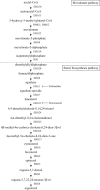Evolution of the Sterol Biosynthetic Pathway of Pythium insidiosum and Related Oomycetes Contributes to Antifungal Drug Resistance
- PMID: 28115356
- PMCID: PMC5365696
- DOI: 10.1128/AAC.02352-16
Evolution of the Sterol Biosynthetic Pathway of Pythium insidiosum and Related Oomycetes Contributes to Antifungal Drug Resistance
Abstract
Pythiosis is a life-threatening infectious disease caused by the oomycete Pythium insidiosum Direct exposure to Py. insidiosum zoospores can initiate infections of the eye, limb, gastrointestinal tract, or skin/subcutaneous tissue. Treatments for pythiosis have mostly relied on surgery. Antifungal drugs are generally ineffective against Py. insidiosum However, one patient with an invasive Py. insidiosum infection recovered completely following treatment with terbinafine and itraconazole. Additionally, the drug target sterol biosynthetic enzymes have been identified in the oomycete Aphanomyces euteiches It remains an open question whether Py. insidiosum is susceptible to the antifungal drugs and harbors any of the known drug target enzymes. Here, we determined the in vitro susceptibilities of terbinafine and itraconazole against 30 isolates of Py. insidiosum We also analyzed endogenous sterols and searched for genes encoding the sterol biosynthetic enzymes in the genomes of Py. insidiosum and related oomycetes. The susceptibility assay showed that the growth of each of the Py. insidiosum isolates was inhibited by the antifungal agents, but only at difficult-to-achieve concentrations, which explains the clinical resistance of the drugs in the treatment of pythiosis patients. Genome searches of Py. insidiosum and related oomycetes demonstrated that these organisms contained an incomplete set of sterol biosynthetic enzymes. Gas chromatographic mass spectrometry did not detect any sterol end products in Py. insidiosum In conclusion, Py. insidiosum possesses an incomplete sterol biosynthetic pathway. Resistance to antifungal drugs targeting enzymes in the ergosterol biosynthetic pathway in Py. insidiosum was due to modifications or losses of some of the genes encoding the drug target enzymes.
Keywords: Pythium insidiosum; antifungal drug; evolution; in vitro susceptibility; pythiosis; sterol biosynthetic enzyme.
Copyright © 2017 American Society for Microbiology.
Figures




References
-
- Mendoza L, Ajello L, McGinnis MR. 1996. Infection caused by the oomycetous pathogen Pythium insidiosum. J Mycol Med 6:151–164.
-
- Krajaejun T, Sathapatayavongs B, Pracharktam R, Nitiyanant P, Leelachaikul P, Wanachiwanawin W, Chaiprasert A, Assanasen P, Saipetch M, Mootsikapun P, Chetchotisakd P, Lekhakula A, Mitarnun W, Kalnauwakul S, Supparatpinyo K, Chaiwarith R, Chiewchanvit S, Tananuvat N, Srisiri S, Suankratay C, Kulwichit W, Wongsaisuwan M, Somkaew S. 2006. Clinical and epidemiological analyses of human pythiosis in Thailand. Clin Infect Dis 43:569–576. doi:10.1086/506353. - DOI - PubMed
-
- Thianprasit M, Chaiprasert A, Imwidthaya P. 1996. Human pythiosis. Curr Top Med Mycol 7:43–54. - PubMed
MeSH terms
Substances
LinkOut - more resources
Full Text Sources
Other Literature Sources

